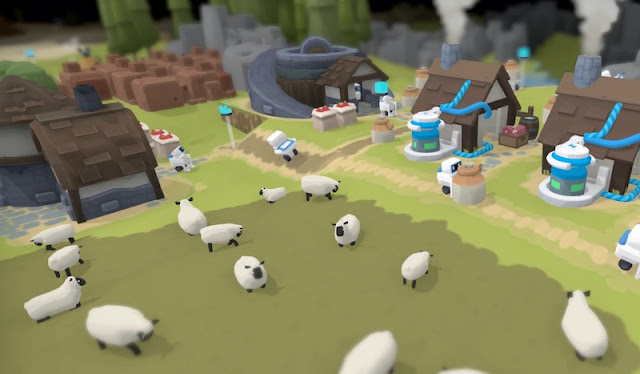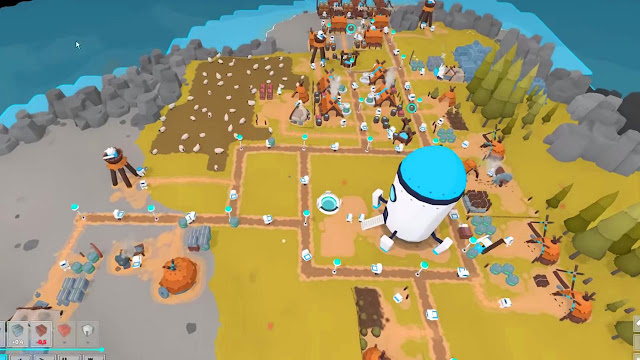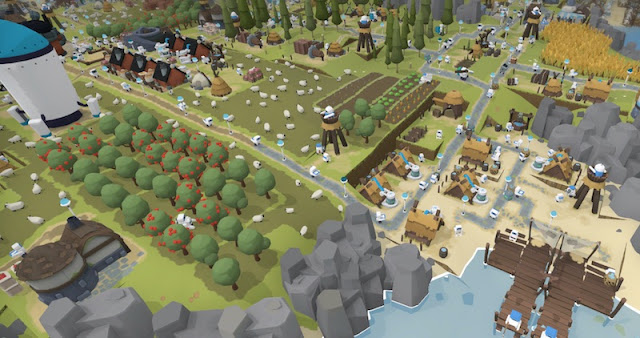The Colonists is like peaceful Age of Empires, or Forager with a more robust mission structure. If that sounds amazing, I’m sure you’ll already love this game. It’s a strictly single-player engine builder, with slowly growing cities mining primary resources and refining them into secondary and then tertiary products, driving upgrades that allow you to mine the map more efficiently to create more impressive stuff. Some design choices do hold the game back from fully achieving its vision, and by the time I’d exhausted the available missions I was properly done with this game for good, but for the time that it lasted, The Colonists was simple, intuitive and excellent fun.
At its core, this is entirely a game about resource management. The map provides trees, rocks, various ores and the player has free reign to create their robotic civilisation. A satisfying amount of the game is automated – workers cut wood or mine stone on their own, and resources are brought to their destinations using an intuitive road and pathway system. The player is in charge of only the high-level thinking.
There’s an anecdote about Age of Empires 2 where the developers had intended a fifth resource called ore, which would have simulated metal for swords and armour, leaving gold to be solely for economic purposes. This fifth resource was eventually cut to streamline resource management and make the game more driven by combat. But this means that resources in Age of Empires (and just about every other RTS of its kind) are an abstraction: if I paid 250 food and 250 gold at a blacksmith to research Chainmail, for example, the food and gold would imply that manpower and economic trading would be required to create the armour for my soldiers. The Colonists takes the opposite approach: there is very little abstraction, and instead there are over 50 kinds of raw or refined resources available to work with.
As players start out they’ll only have access to the basics: wood, stone and food. Lumberjack Huts extract Wood which can be refined at the Sawmill into Timber, which then can be used at a Workshop to upgrade Mining Camps enabling the extraction of Iron Ore, which can then be combined with Charcoal (another form of refined Wood made from a Blasting Furnace) to create Iron Ingots, which are then transformed at Blacksmiths into Tools. This interaction involved six different types of resources transported across six specialised buildings, and that’s less than a quarter of how deep the tech-tree in this game goes. If the prospect of a resource chain this complicated brings you excitement rather than dread, then The Colonists is the game for you.
Solo levels task the player with upgrading until they can build a Monument – a large, costly building that requires various high-end resources. It’s similar to building a Wonder in Age of Empires: the effort required is a demonstration of a player’s mastery over the game. There are bronze, gold and silver medals to be earned depending on how much time the player takes to achieve this task. Later solo levels will place resources further away, on hostile terrain like deserts or in mountain ranges, or across rivers that must be traversed by boat. The gold requirements become very challenging, and require forethought to beat.
There are also competitive levels, which will pit players against an AI to dominate territory as fast as possible. The Colonists works off a fog-of-war system based on Watchtowers, which grant the player a circle of influence around them. If any building falls into the influence of another player’s Watchtower, it spontaneously combusts.
Combat is strongly deemphasised in The Colonists. Not only are there no military units, but Watchtowers can only attack after several upgrades have been obtained. The enemy AI is rather expansionist on everything other than Casual difficulty, so most of the player’s efforts will need to be spent on building Watchtowers rather than dealing with the actual fun side of resource refinement. I found that the competitive levels were far less rewarding to play compared to the solo levels – the best way to win was to rush down the AI opponent and research Arrows before the opponent did; otherwise there was nothing that could be done except to restart.
The Colonists is a strictly single-player experience, with eight solo missions and five competitive missions. That might not sound like a lot, but each mission takes about an hour to complete and it’s unlikely you’ll get a gold medal on the first try, so the replay value is there if you want it. An additional challenge mode will task players with reaching more specific goals with strict time limits, and I wish there were more of these – these really pushed my knowledge of the mechanics to the limit.
Since the game does track how long it takes to finish each mission, there is some fun to be had in speed runs. There are no online leaderboards, but it’s still a great feeling to beat a previous time through sheer efficiency and forethought. This is where the game’s PC roots rear their head, too – though it’s perfectly playable on Switch, there’s a degree of granular control which is best done with a mouse and keyboard.
As much as I loved my first few hours with The Colonists, it did, unfortunately, wear out its welcome after a while. The technology tree, while expansive, is also quite linear – most missions will have players eventually congregating towards the same end game resources. The different maps do provide some strategic depth, but even then the game is low on new ideas by the end of the thirteen missions. While a random-map option would have been nice, I’ve had all the enjoyment I think I’m ever going to get with this game. It’s great while it lasts, but I would have loved for the developers to further explore the idea of complex resource trees in a more open-ended way.











